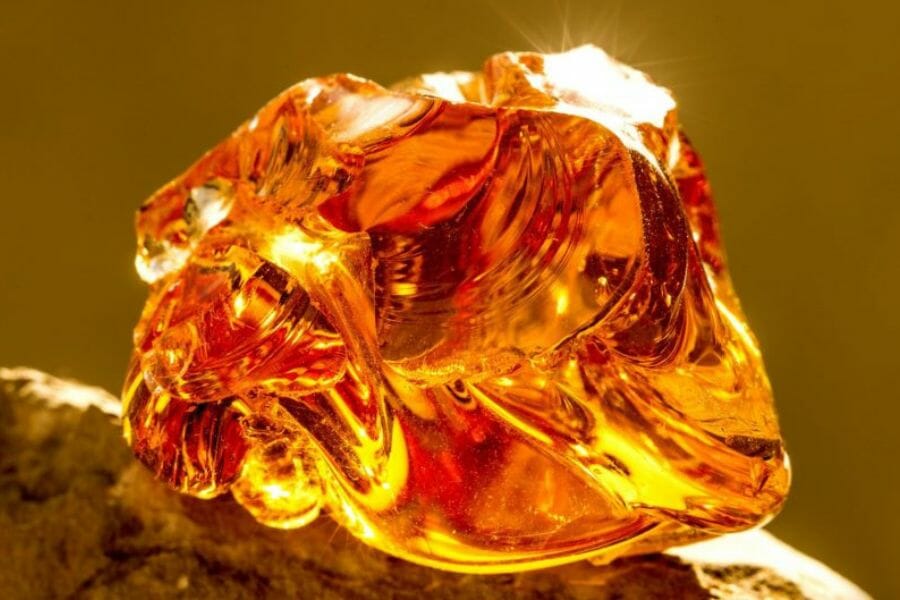If you’re fascinated by the colorful world of rocks, minerals, gems, and crystals, then you’ve come to the right place! In this article, we’ll take a closer look at the ever-so-vibrant and cheerful color of ORANGE.
This color brings a burst of energy and positivity to any room, and it’s just amazing how there’s a whole world of orange gems, minerals, crystals, and rocks just waiting to be explored. These specimens aren’t just pretty— they have a story to tell and a history to share.
So whether you’re a collector, a rock-hound or just someone who loves all things orange, this article is for you. Get ready to be inspired and amazed by the beauty and diversity of orange rocks, minerals, gems, and crystals. Let’s dive in!
Orange Gems And Crystals
Here are some of the most head turning, eye catching orange gems and crystals that you can find. We made sure to include a photo for each of them so you can take in their beauty one at a time.
Amber – C10H16O
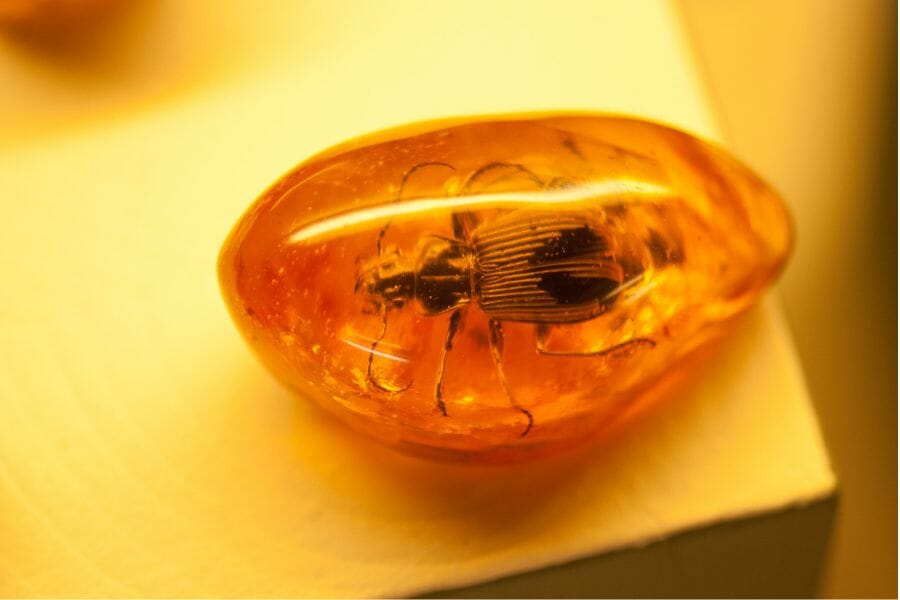
This orange gem has been capturing hearts and catching stares for centuries! With its warm color and unique history, Amber is a true treasure of the natural world.
It’s formed from ancient tree resin that has been preserved for millions of years. Yes, you read that right: millions of years! So when you hold an Amber in your hand, you’re holding a piece of history that’s older than the dinosaurs.
From jewelry and decoration to scientific research and even as a healing tool, Amber has been put to good use for thousands of years. Ancient civilizations like the Greeks and Romans even believed that it had special healing powers.
Fun Fact Amber, with all its glowing, eye-catching beauty, is also considered as "nature's time capsule". Because it contains tiny bits of ancient insects and plant matter, this gem can provide a unique glimpse into the past and the ecosystem at the time the resin was formed. This makes Amber a valuable tool for learning about the Earth's history and evolution.
Where Amber is found
Amber can be found in various places around the world! It’s most commonly found in the Baltic region, specifically the countries of Latvia, Lithuania, and Estonia, but it can also be found in other countries such as Mexico, Dominican Republic, and even the US. Since it’s created from ancient tree resin, this gem can be found near coastlines and in ancient forests where the resin was preserved over millions of years. So, if you’re ever in the Baltic region, or near a coastline, keep an eye out for this treasure!
How you can identify an Amber
- Color: Amber has a warm, golden-orange hue that’s reminiscent of the sun and a little bit of honey. It can range from a light, sunny yellow to a rich, golden brown. And just like the gem itself, Amber’s color can contain tiny flecks and variations.
- Hardness: Amber’s hardness is rated at 2.5-3 on the Mohs scale, which means it’s relatively soft. Although it can scratch easily, its softness also allows it to be carved and shaped into intricate and beautiful pieces, like jewelry and decorative objects.
- Clarity: Amber’s clarity can vary greatly depending on the piece. Some are crystal clear, with no inclusions or bubbles, while others have tiny flecks of plant matter or insects trapped inside.
- Refractive index: Amber’s refractive index is low at 1.54. When light enters Amber, it disperses more slowly, giving the gem its warm and golden hue. It also means that Amber has a low level of brilliance and fire.
- Specific gravity: Amber’s specific gravity is 1.05-1.10, which means it’s lightweight. This makes it more comfortable to wear in jewelry, as it won’t weigh you down. But this also means that Amber is less dense, so it’s more susceptible to damage.
Spessartite Garnet – Mn2+3Al2(SiO4)3
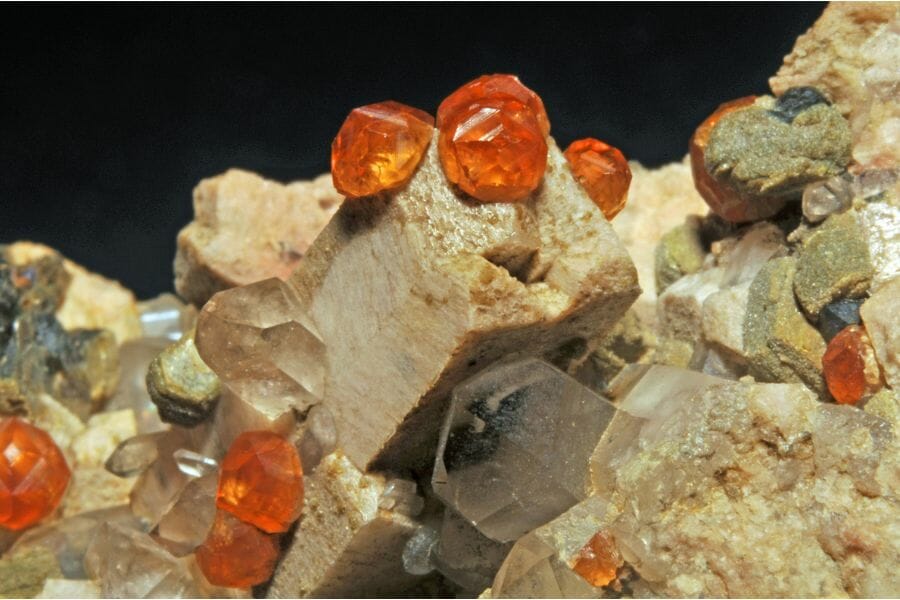
Spessartite Garnet was first discovered in the Spessart Mountains of Germany in the late 19th century and quickly became a sought-after gem. Its warm color makes it a stand-out in any jewelry collection, and its durability makes it a practical choice for everyday wear.
This gem has been used in jewelry for centuries, and its popularity has only grown in recent years. The warm and fiery orange color of Spessartite Garnet is a great alternative to traditional, more expensive red gems.
In addition to its beauty, Spessartite Garnet is also valued for its rarity. It’s not as commonly found as other garnet varieties, and high-quality specimens can be difficult to come by. If you’re looking for a truly unique orange gem, this is definitely worth considering!
Fun Fact Speaking of color orange, did you know that Spessartite Garnet is also often referred to as the "Mandarin Garnet"? This is thanks to its vibrant orange color, reminiscent of the fruit. This just goes to show how special and eye-catching this gem truly is!
Where Spessartite Garnet is found
Spessartite Garnet is often found in combination with other minerals like mica, feldspar, and quartz. It’s found in a few different locations around the world, especially in the Spessart Mountains in Germany where it was first discovered. This variety of garnet is also found in Nigeria, Mozambique, Madagascar, Namibia, and Tanzania. But don’t expect to find it just anywhere in these countries as it’s considered a rare gemstone.
How you can identify a Spessartite Garnet
- Color: Spessartite Garnet is known for its warm, orange color, which sets it apart from other garnet varieties. It can range from a soft apricot to a deep, rich orange.
- Hardness: Spessartite Garnet is a relatively hard gem, with a Mohs hardness rating of 6.5 to 7.5. It’s durable enough for daily wear, but it’s still important to handle it with care to prevent scratches and chips.
- Clarity: Spessartite Garnet can have varying levels of clarity from transparent to slightly included. It’s not known for being the most crystal clear gem out there. Some may even have inclusions, or tiny imperfections, that can be seen with the naked eye.
- Refractive index: The refractive index of Spessartite Garnet ranges from 1.738 to 1.759. This falls in the average range for gemstones.
- Specific gravity: Spessartite Garnet’s specific gravity is around 4.32, which is relatively high. This makes it feel substantial and durable in the hand— perfect for jewelry pieces that’s meant to last a lifetime!
Sunstone – (Ca,Na)((Al,Si)2Si2O8)
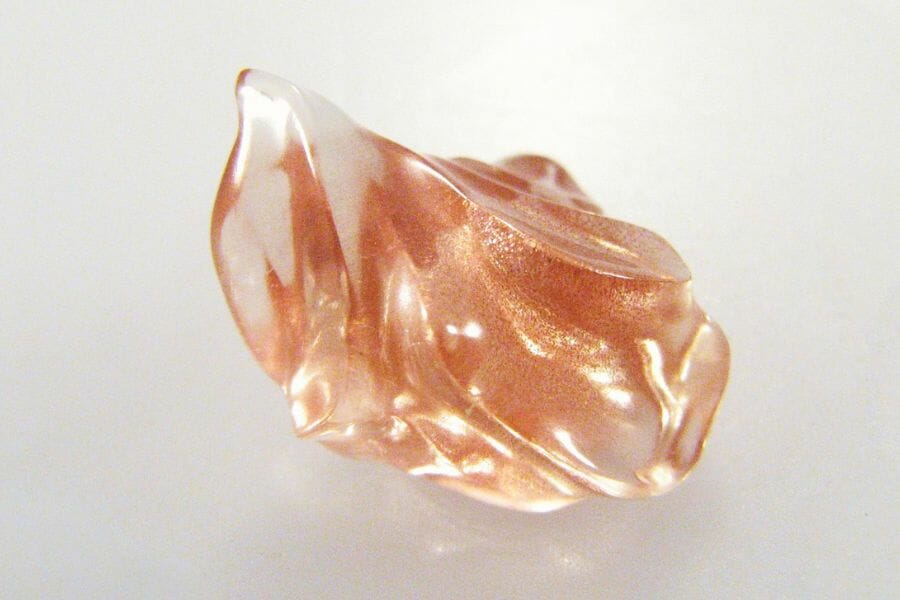
Sunstone has been used for centuries for its beauty and unique appearance. It was prized by ancient civilizations for its warm color and was believed to have mystical properties that could bring good luck and prosperity.
It’s a feldspar mineral with a unique shimmering effect that’s caused by the presence of tiny platelets of hematite or goethite. This is what gives Sunstone it’s signature sparkle!
In recent years, Sunstone has become increasingly popular and it shows no signs of slowing down. Whether it’s for its beauty, durability, or mystical properties, it’s a gem that’s definitely worth exploring.
Fun Fact Sunstone's aventurescence (a unique optical phenomenon that causes a gem to dazzle and shimmer) is so eye-catching and mesmerizing that it's often described as a "dance of light" or a "sunburst" of sparkles. Glowing is an understatement!
Where Sunstone is found
Sunstone is found in various locations across the world, but some of the most well-known sources of sunstone include Oregon in the United States, Ontario in Canada, Norway, India, and Russia. It can be found in volcanic rocks, like basalt, as well as in placer deposits, which are formed when minerals are washed away from their original location and concentrated in riverbeds or on beaches. It’s also possible to find Sunstone in pegmatites, which are large, coarse-grained igneous rocks that contain large mineral crystals.
How you can identify a Sunstone
- Color: Sunstone comes in a range of colors, including orange, yellow, red, green, and even blue, but the most common type is warm and sunny orange. The intensity of its color can vary from light and subtle to deep and rich.
- Hardness: Sunstone has a hardness of 6 on the Mohs scale, which makes it a relatively durable gemstone that can withstand normal wear and tear. Just be careful not to expose it to excessive heat or chemicals, which can weaken it over time.
- Clarity: Sunstone’s clarity varies depending on where it’s sourced from and the quality of the stone. It can range from being virtually flawless with no visible inclusions to having a host of visible inclusions, which can impact its clarity.
- Refractive index: Sunstone’s refractive index can range from 1.529 to 1.544. It falls in the middle range, which means it has good sparkle and brilliance, making it a great choice if you want a gem that’s flashy, but not too over-the-top.
- Specific gravity: Sunstone’s specific gravity ranges from 2.64-2.72, depending on where it’s sourced. It’s a bit lighter than most other gems, which makes it stand out.
Fire Opal – SiO2 · nH2O
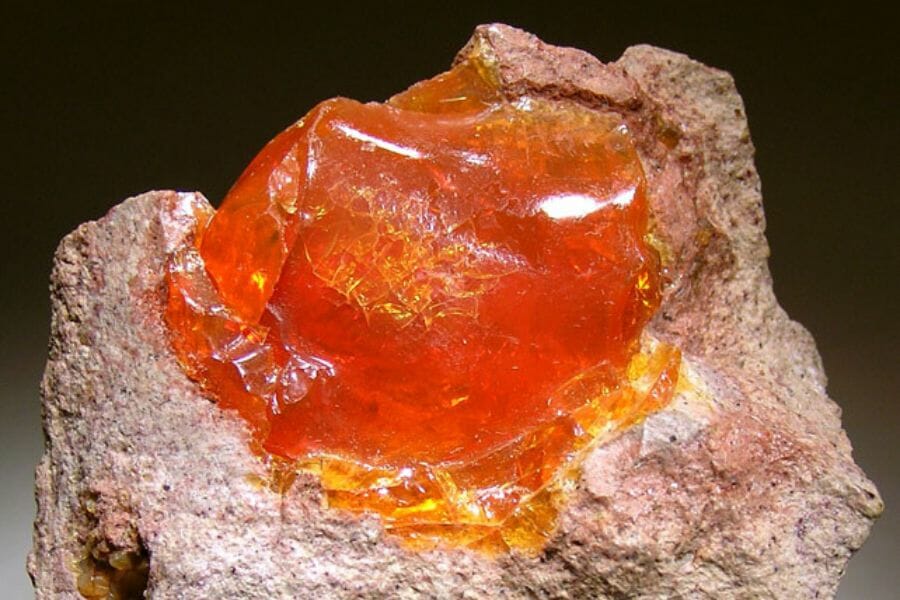
For centuries, Fire Opal has been prized for its beautiful and fiery color. It has a long and fascinating history that dates back to ancient civilizations, who believed that it held magical powers. The Aztecs, in particular, were known to have used Fire Opal in their jewelry and religious ceremonies for good luck and protection.
In more recent times, Fire Opal has been highly valued by gem collectors and jewelry enthusiasts due to its rare and radiant appearance. It’s often used in unique and eye-catching jewelry designs, where its fiery color and remarkable transparency can be fully appreciated. Eye-catching, indeed!
Fun Fact: Fire Opal knows how to play! This gem is known for a phenomenon called "play-of-color" which is a display of rainbow-like colors that appear to change and move as the gemstone is viewed from different angles. This feature adds to the Fire Opal's unique and mesmerizing appeal.
Where Fire Opal is found
Fire Opal is found in many countries, but the most notable locations include Mexico, Australia, Brazil, Honduras, and the US, particularly in Nevada. Mexico is particularly famous for producing high-quality Fire Opals with bright, intense colors. In addition, this gem is also found in smaller deposits in other countries, including the Czech Republic, Slovakia, Ethiopia, and Turkey. With its unique color and beauty, Fire Opal has long been prized by gem collectors and jewelry makers who go to these location just to find it.
How you can identify a Fire Opal
- Color: Fire Opal’s color varies from yellow, orange, red, and sometimes, brown. It’s famous for its vibrant and intense orange hues.
- Hardness: Fire Opal’s hardness ranges from 5.5 to 6.5 on Mohs scale. It’s relatively soft compared to other gemstones and should be handled with care to prevent scratches and chips, but it’s still tough enough to withstand everyday wear and tear.
- Clarity: Fire Opal has moderate clarity with some inclusions and fractures that can be seen when closely observed. While the clarity can vary, in general, Fire Opal is translucent to transparent.
- Refractive index: Fire Opal’s refractive index ranges from 1.44-1.46, which is considered low. It has a lower ability to bend light which, coupled with its often cloudy appearance, gives it a lower clarity grade.
- Specific gravity: Fire Opal’s specific gravity ranges between 2.0-2.4, which is lower than most other gemstones. It’s typically composed of hydrated silica, which gives it this lightness.
Crocoite – PbCrO4
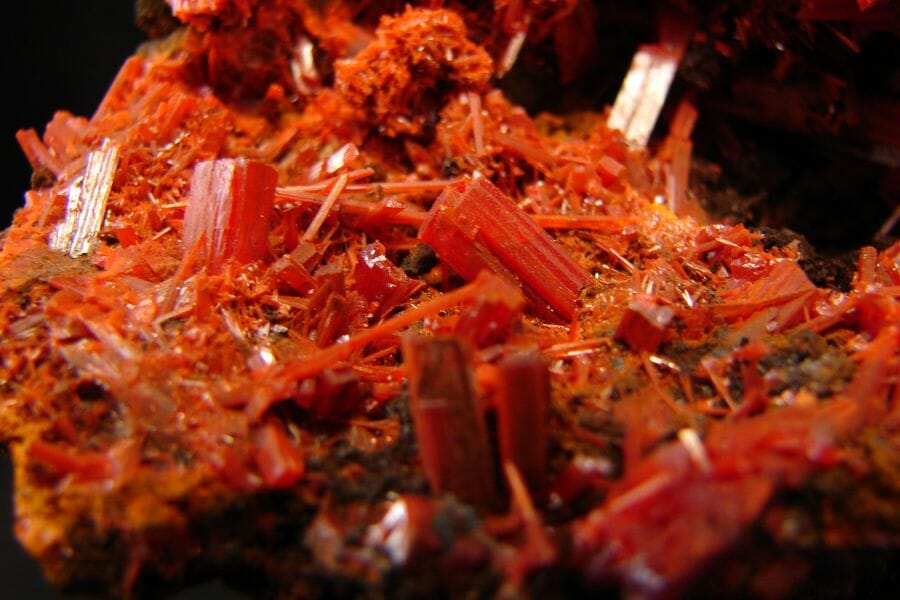
Crocoite is believed to have first been discovered in the early 19th century in the mountains of Russia. But it wasn’t until the discovery of large deposits in Tasmania, Australia in the mid-19th century that it started to receive recognition.
This gem was initially used as a pigment due to its vibrant color. However, the discovery of its toxicity meant it was soon replaced by safer alternatives.
Despite this, Crocoite is still valued today for its unique and intense color and its rarity, making it a popular gem among collectors.
Fun Fact:
The largest found crystal of Crocoite weighed in at over 2 pounds, making it a true spectacle in the gem world!
Where Crocoite is found
Crocoite is found in few places around the world, but the main source of this gem is the Dundas region of Tasmania, Australia. It’s also found in smaller deposits in Russia, South Africa, and the United States. It’s not a widely distributed gem, making it a rare and valuable specimen for collectors.
How you can identify a Crocoite
- Color: Crocoite is often described as a vivid and striking orange-red color caused by the presence of lead in the mineral. Its color is so unique, it’s often immediately recognizable.
- Hardness: Crocoite has a Mohs hardness of 2.5-3. It is relatively soft compared to other gems, making it prone to scratches and breakage.
- Clarity: Crocoite’s clarity varies: it can be translucent or opaque. Its crystal formations can have inclusions that are visible. It can have some cracks sometimes, that’s why it’s not a commonly used gemstone.
- Refractive index: Crocoite’s refractive index falls in the range of 1.9-2.1, which is considered medium for a gem.
- Specific gravity: Crocoite’s specific gravity is around 5.0 to 5.2, which is relatively heavy. This makes it suitable for cutting into gems, even though it’s not commonly used due to its rarity and softness.
Wulfenite – PbMoO4
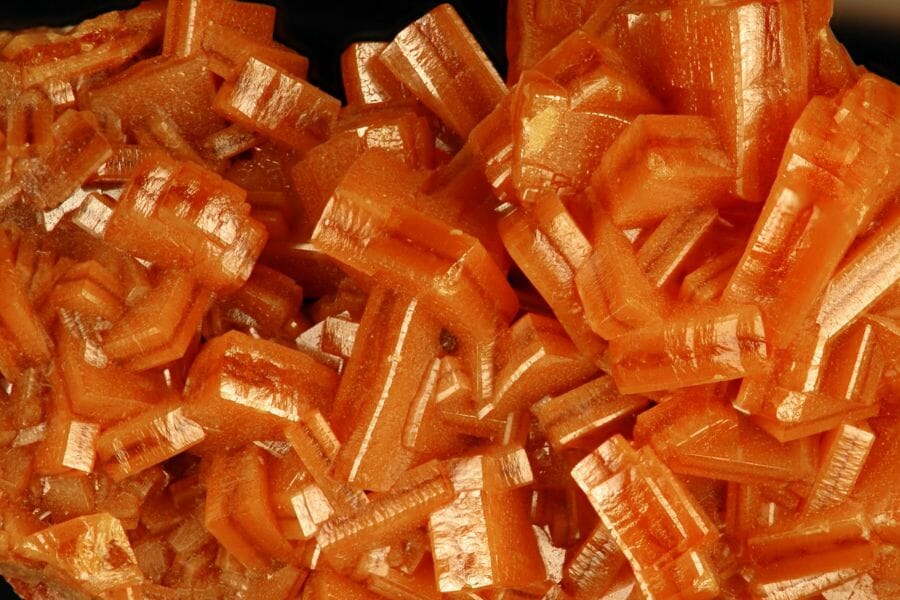
Wulfenite was first discovered in the late 1700s by an Austrian mineralogist named Franz Xaver von Wulfen. It’s often found as tabular, prismatic, or scalenohedral crystals, and is sometimes accompanied by other gems, like mimetite and vanadinite.
Wulfenite was initially used as a lead ore and was extracted for its high lead content, which was a valuable resource in the 19th century. Today, it’s still used in some industries as a source of lead, but it’s primarily prized for its aesthetic beauty and rarity. It is a popular gem among collectors and has been featured in gem exhibitions around the world.
Wulfenite’s striking color and crystal structure have earned it a place among the world’s most treasured gems!
Fun Fact: Wulfenite is known for its unique crystal formations called "tetragonal crystal structure". It's often shaped like tabular plates, short prismatic crystals, or thin blades. Some specimens of Wulfenite also have a velvety texture that's caused by a powdery coating of microcrystals on their surface.
Where Wulfenite is found
Wulfenite is found in a few places in the world, including Mexico, the US (Arizona and California), Namibia, and a few other countries. It’s commonly found in lead deposits. The largest deposit of Wulfenite was discovered in the Red Cloud Mine, in La Paz County, Arizona.
How you can identify a Wulfenite
- Color: Wulfenite’s color varies, but it’s often found in shades of yellow, orange, brown, and red, sometimes with a gray or white outer layer. Some specimens have also been found in blue and green.
- Hardness: Wulfenite’s hardness is is at 2.5 to 3 on the Mohs scale. It’s a relatively soft gem, which means it can be scratched easily. But it’s still durable enough to be used in jewelry and other decorative objects.
- Clarity: Wulfenite’s clarity depends on the amount of impurities, so it can range from clear to cloudy and from translucent to opaque.
- Refractive index: Wulfenite’s refractive index is 2.2, which is considered low and gives it a somewhat dull appearance compared to gems with higher refractive indices.
- Specific gravity: Wulfenite’s specific gravity is around 4.5 to 5, which is relatively heavy for a gem.
Vanadinite – Pb5(VO4)3Cl
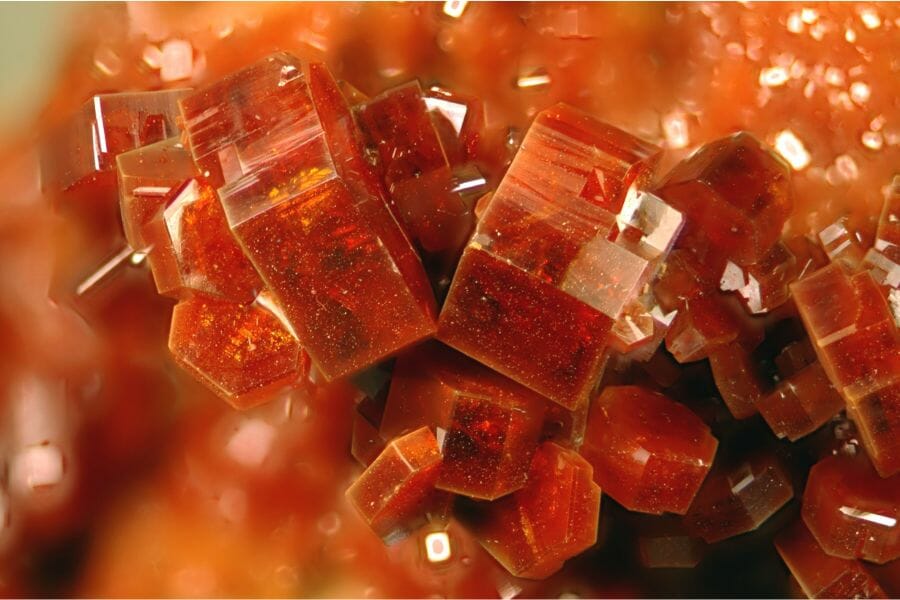
Vanadinite was first discovered in Mexico in the 1880s. It gets its color from small amounts of vanadium in its crystal structure.
This gem has been used for a variety of purposes throughout history. In the past, it was used as a source of lead and vanadium. Because of its unique color and crystal formation, it’s highly sought after by mineral collectors. Some pieces of Vanadinite can display complex crystal formations, making them particularly prized.
It’s also sometimes used in jewelry for its vibrant color. It’s often used as a cabochon, or as beads in necklaces and bracelets. Because of its relatively soft nature, it’s often combined with other minerals such as quartz to create more durable jewelry pieces.
Fun Fact Did you know that Vanadinite can fly planes and jets and move cars? It's because of vanadium! This element is an important component in alloys for airplane, car engine parts, and even jet engines.
Where Vanadinite is found
Vanadinite is found in various locations, but some of the main sources are Mexico, Morocco, Namibia, and South Africa. It’s commonly found in arid regions as a secondary mineral in oxidized zinc-lead deposits.
How you can identify a Vanadinite
- Color: Vanadinite is known for its vibrant, bold color, often ranging from deep orange, red, brown to yellow-brown. It can be found with a range of intensities, but the finest specimens often have a strong, bright hue.
- Hardness: Vanadinite’s hardness is rated at 3.5-4 on Mohs scale, which means it’s a gem that’s soft enough to be scratched with a knife or a fingernail.
- Clarity: Vanadinite clarity varies: it’s sometimes transparent, sometimes translucent, and sometimes opaque, depending on the formation conditions. It can also contain inclusions and be clouded, affecting its clarity.
- Refractive index: Vanadinite’s refractive index is usually around 2.4-2.5, which is considered average for gems.
- Specific gravity: Vanadinite’s specific gravity is around 5.8 – 6.2 (g/cm^3). It’s generally considered heavy for its size.
Orange Rocks
The shimmering orange gems and crystals may have awed you, but the following list of orange rocks will surely hook you some more— especially when you find out just how versatile they are, too!
Wonderstone
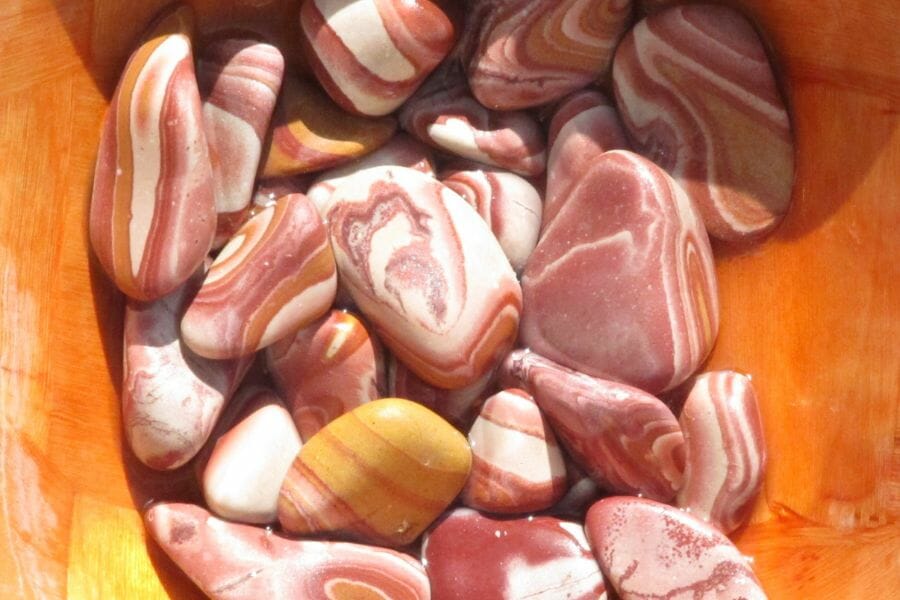
Wonderstone, also known as Rhyolite, is a type of igneous rock that formed from volcanic activity. It’s known for its unique appearance of swirling patterns. The stone has a long history of use, going back to ancient civilizations that used it for making jewelry, carvings, and other decorative items.
In the 19th century, Wonderstone became a popular material for making cameos, which were fashionable during the Victorian era. The stone’s unique appearance, combined with its ability to take a high polish, made it a popular choice for these decorative pieces.
Today, Wonderstone continues to be valued for its unique appearance and is still used for making jewelry, decorative items, and landscaping. It’s not an expensive material, making it an affordable option for those looking to incorporate natural beauty into their lives.
Fun Fact:
Wonderstone is named after the Old English word "wunder," meaning "miracle," because of its unique, eye-catching appearance. True enough, it's been used in ornamental applications such as in creating beautiful vases, bowls, and decorative tiles.
Where Wonderstone is found
Wonderstone is mostly found in the western US, especially in Oregon, as well as in Canada and South Africa. Some other locations where it can be found include Australia, Chile, and Namibia. Wonderstone is often a byproduct of volcanic activity or is found in sedimentary formations.
How you can identify a Wonderstone
- Color: Wonderstone’s color is usually orange-brown, reddish-brown or yellow-brown, but can sometimes be tinged with green, gray, or purplish hues. It’s mineral components give it its distinct color. In some instances, Wonderstone displays interesting patterns like swirls, banding, and even fossils.
- Hardness: Wonderstone’s hardness ranges from 3-4 on the Mohs scale. It’s relatively soft, but can still hold up to light wear. It can be scratched by a knife, but can withstand light handling, making it good for use in decorative items and crafts, but not for jewelry.
- Clarity: Wonderstone can have varying degrees of transparency ranging from semi-transparent to opaque. Its clarity depends on the presence of impurities and inclusions, and the size and number of these inclusions.
- Specific gravity: Wonderstone’s specific gravity usually falls in the range of 2.5-2.9. It’s relatively heavy for its size compared to other rocks.
Iron Ore – Fe2O3
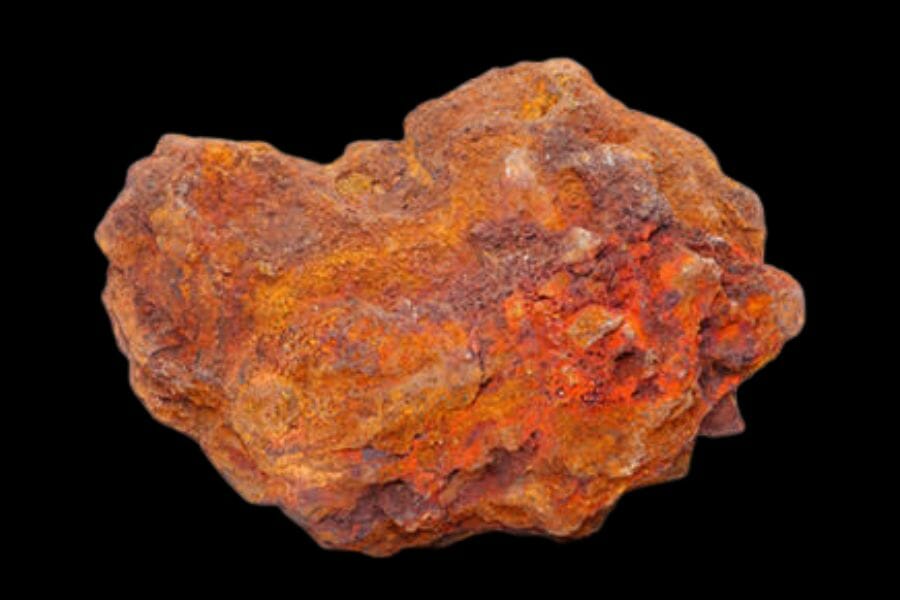
Iron ore is a vital material for human civilization as it is the primary source of iron, a crucial element in many aspects of modern life. Iron has been used for thousands of years, dating back to ancient civilizations where it was used to make weapons and tools. It was also the first metal to be smelted and used by humans, and its discovery allowed for the advancement of many civilizations.
Iron ore is a combination of various minerals, including iron oxides, hematite, and magnetite, which are mined and processed to extract the iron.
Iron is a highly valued material due to its strength, durability, and versatility. It is used in the production of a wide variety of products: from steel, which is used to build bridges and skyscrapers to automobiles and household appliances. Iron also plays a crucial role in the production of many industrial products, including construction materials, machinery, and electronics.
Fun Fact: Driven by the rapid industrialization of many countries and growth of the world economy, the demand for Iron Ore increased dramatically. Today, it's mined in about 50 countries! Australia and Brazil together are world's top exporters of iron ore, owning 1/3 of the total exports.
Where Iron Ore is found
Iron ore is found all over the world, but the largest reserves are in Australia, Brazil, Russia, China, and India. Other countries with significant deposits include Ukraine, Kazakhstan, South Africa, and the US. Deposits can be found near the surface or deep underground, and are usually extracted through either open-pit or underground mining.
How you can identify an Iron Ore
- Color: Iron ore comes in a variety of colors, including orange, red, yellow, grey, black, or brown. It all depends on the type of iron mineral present in the rock. Some may also contain trace minerals, which can give the rock a unique color.
- Hardness: Iron ore’s hardness can vary, but in general, it’s considered to be pretty hard at around 5.5 to 6.5 on Mohs scale.
- Clarity: Iron ore’s clarity can vary depending on the type. Some iron ores may have inclusions, blemishes, or impurities that affect its clarity. However, pure iron ores are not transparent.
- Specific gravity: Iron ores have a specific gravity of around 4.5 to 5.3, depending on the type of mineral it’s consist of. It’s dense and heavy for its size.
Ignimbrite
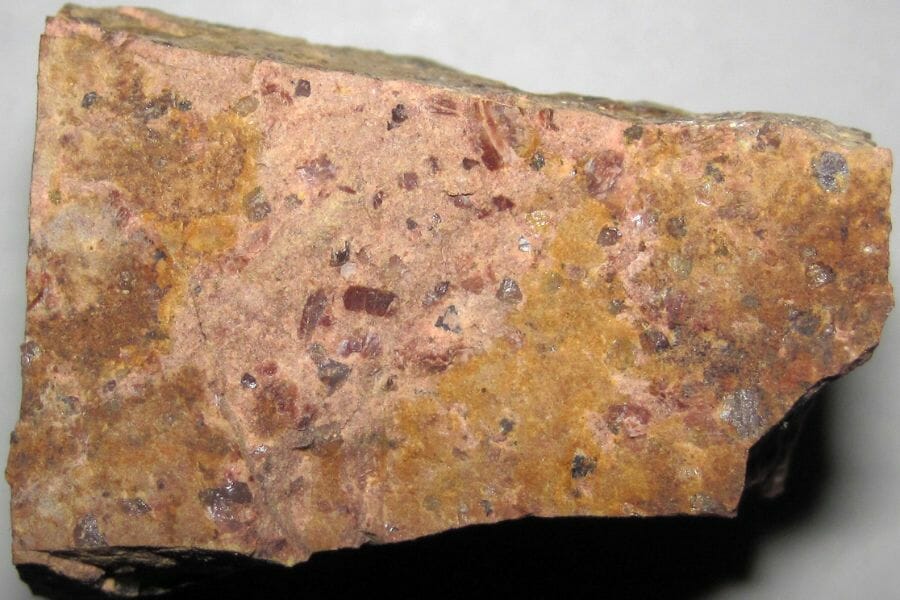
The name “Ignimbrite” is derived from the Latin word “ignis,” which means fire. True to this, Ignimbrite’s formed from ash, pumice, and other volcanic materials that have been rapidly deposited and solidified during a volcanic eruption. It’s a relatively young rock, dating back to only a few million years ago.
Ignimbrite has a variety of uses, including as a building material, as a source of aggregate for construction, and as a soil amendment. In some cases, it has been used as a source of geothermal energy.
Ignimbrite is valued for its unique properties, including its porosity, which makes it ideal for use in construction and landscaping. It’s also highly valued for its textural and compositional variability, which makes it useful for geological and geomorphological studies.
Fun Fact:
Ignimbrites can give us warning! Did you know that this volcanic rock can reveal a lot about past volcanic eruptions? Scientists use Ignimbrite to understand the type of magma that was erupted, how the eruption occurred, and how long it took for the pyroclastic flow to cool and solidify. By studying Ignimbrites, they can get a better understanding of past volcanic activity, which can be useful for forecasting future volcanic eruptions and for hazard assessments.
Where Ignimbrite is found
Ignimbrite is found in various regions around the world where volcanic activities, such as eruptions or ash falls, have occurred. Some of the well-known locations include parts of the western US, New Zealand, and Italy. The deposits of Ignimbrite can be quite extensive and often form layered sequences that can be thousands of meters thick.
How you can identify an Ignimbrite
- Color: Ignimbrite can range from light gray to dark gray, to brown or even black with rusty, orange hues due to presence of iron-rich minerals. The coloration can be uniform or streaked, depending on the flow patterns during formation.
- Hardness: Ignimbrite’s hardness falls in the range of 5-6 on the Mohs scale, which is considered moderately hard. Since it’s composed of volcanic ash, fragments of lava, and other volcanic material, its hardness may be influenced by the types of materials it’s made of and how they’ve been compacted together.
- Specific gravity: Ignimbrite specific gravity falls between 2.0-2.5, which is considered light-to-moderate for rocks.However, exact specific gravity depends on mineral composition, which can vary greatly among Ignimbrite samples.
Limonite – FeO(OH)·nH2O
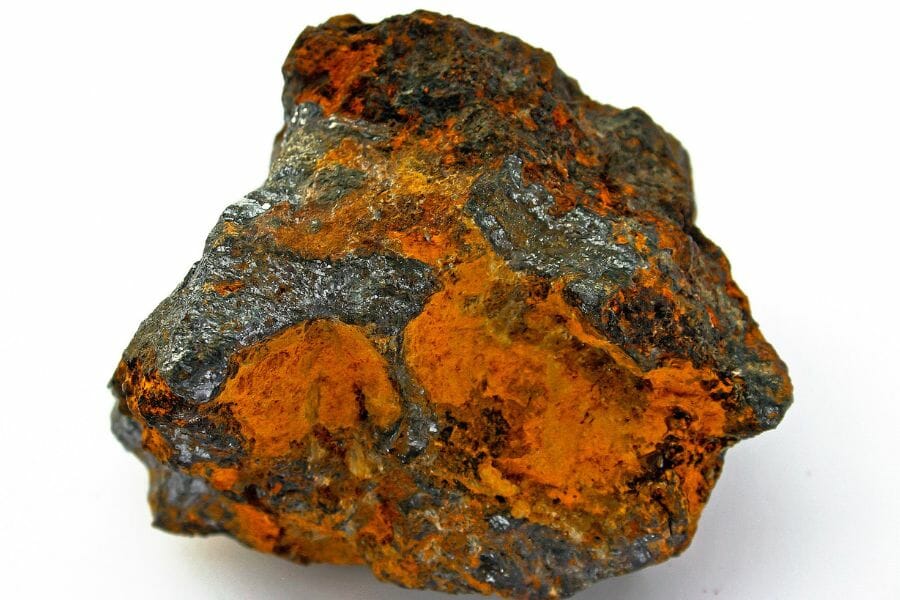
Limonite is a generic name for iron hydroxides, and it’s formed from the alteration of iron-rich minerals, such as hematite and goethite.
This rock is valued because of its iron content, which can be processed into iron and steel. Limonite rock has a wide range of uses including as a pigment in paints, as a component in building materials, and as a filler in various products like rubber, plastic, and ceramics.
In the past, Limonite was used as a source of iron for tools, weapons, and other metal products. Although it’s not as popular as other iron ores today, it still has value due to its abundance and ease of extraction.
Fun Fact Limonite is sometimes called "bog iron ore" because it's often formed in bogs and other wet environments. This rock forms through the weathering of iron-rich minerals, and the constant presence of water helps to break down the minerals and create new ones. So next time you're hiking in a bog or marsh, keep an eye out for Limonite - you might be surprised at what you find!
Where Limonite is found
Limonite can be found in various places across the world, including the US, South America, Europe, Africa, and Asia. It forms in oxidized iron ore deposits and often mixed with other minerals like clay, sand, silt, and sometimes organic materials. Its widespread distribution, due to its formation in many different environments, makes it one of the most abundant iron ores.
How you can identify a Limonite
- Color: Limonite can be orange-brown, reddish-brown, or yellow-brown. Its color is due to the presence of iron in its chemical composition.
- Hardness: Limonite’s hardness varies, but typically falls in the range of 3 to 4 on Mohs scale. It’s a relatively soft rock that can be easily scratched by a fingernail. Its softness makes it an unsuitable material for jewelry, but it still has a variety of uses due to its other properties, such as its high iron content and porous nature.
- Clarity: Limonite’s clarity can vary, but it’s typically opaque. Some may have inclusions or impurities that give it a hazy appearance, while some may have visible veins of iron oxide or other minerals that run through it.
- Specific gravity: Limonite’s specific gravity varies. It usually falls between 2.7 and 4.3, but can range from 2.5 to 5.5. Its varying specific gravity is based on the amount of water present in it.
Siltstone
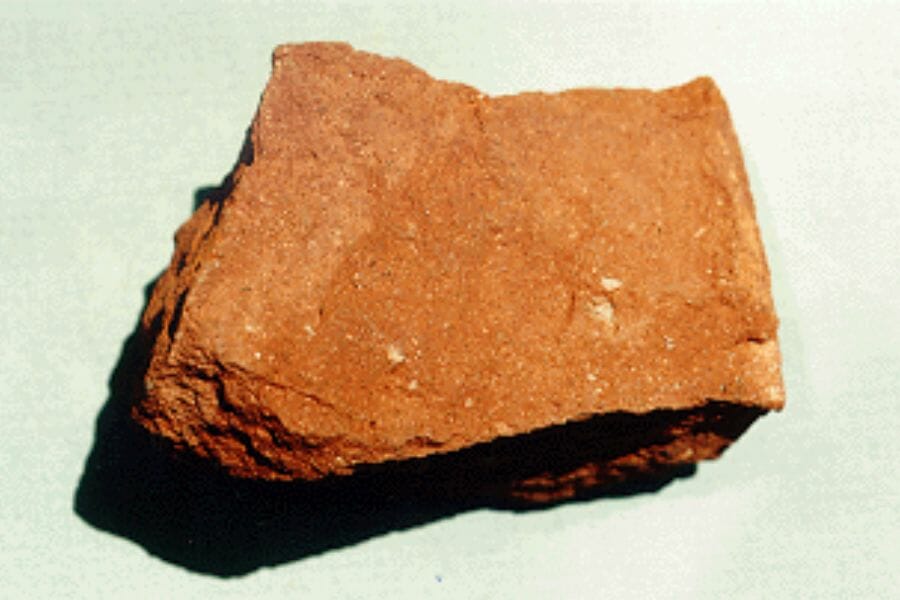
Siltstone is a sedimentary rock made up of very fine grains of silt, which is why it is also known as “shale siltstone”. It’s compsed of tiny particles of clay, feldspar, quartz and other minerals.
It’s been used for various purposes throughout history. In ancient times, Siltstone was used for construction, such as building walls and flooring. It has also been used as a source of fuel as it burns well when dried. It’s also used in landscaping and gardening, as well as in the construction of roads and buildings.
Siltstone is valued because of its durability and resistance to erosion. It’s versatile and can be cut, drilled, and carved into various shapes, making it a useful material in many industries.
Fun Fact
Siltstone was once used to make some of the earliest forms of writing tools. In ancient civilizations, it was carved into sharp, pointy objects that were used as styluses for writing on clay tablets. These tools were a crucial part of the development of written language, and they were used by some of the world's earliest civilizations, including the Mesopotamians, Egyptians, and Mayans. This means that Siltstone has played a significant role in shaping the way we communicate today!
Where Siltstone is found
Siltstone is found in many regions across the world, including North America, South America, Africa, Asia, Europe, and Australia. It forms in sedimentary environments where fine-grained sediments, such as silt and clay, accumulate and are later lithified into rock. It can be found in a variety of geological settings, including river valleys, lakes, oceans, and even near ancient fault lines or within sedimentary basins that were once part of larger ancient oceans. It’s often found near other sedimentary rocks like sandstone, shale, and limestone. So, depending on where you are in the world, you may have access to this interesting and versatile rock!
How you can identify a Siltstone
- Color: Siltstone is typically gray or tan in color, but can also range from orange, red, yellow, brown or green, depending on mineral content. It can be uniform in color or have streaks or mottled patterns. Sometimes, it has a slight metallic sheen.
- Hardness: Siltstone’s hardness varies, but it’s a relatively soft rock with a hardness rating of 2 to 4 on the Mohs scale. It’s often described as being similar to talc. In some cases, though, it can be harder due to its harder minerals or compaction over time.
- Clarity: Siltstone’s clarity can vary greatly depending on its composition, but it’s often described as translucent to opaque (or hazy) with a dull or waxy appearance. The clarity of siltstone may also be influenced by factors like weathering and compaction.
- Specific gravity: Siltstone’s specific gravity is usually around 2.5-2.8. It’s a bit heavy for its size since it’s made up of mainly silt-sized particles that have been compacted and cemented together.
Orange Minerals
Looking for an eye-catching orange mineral? We’ve got you covered! Here’s a list of some of the best ones you can find. Ready your eyes because their glow might blind you!
Gmelinite – Na4(Si8Al4)O24·11H2O
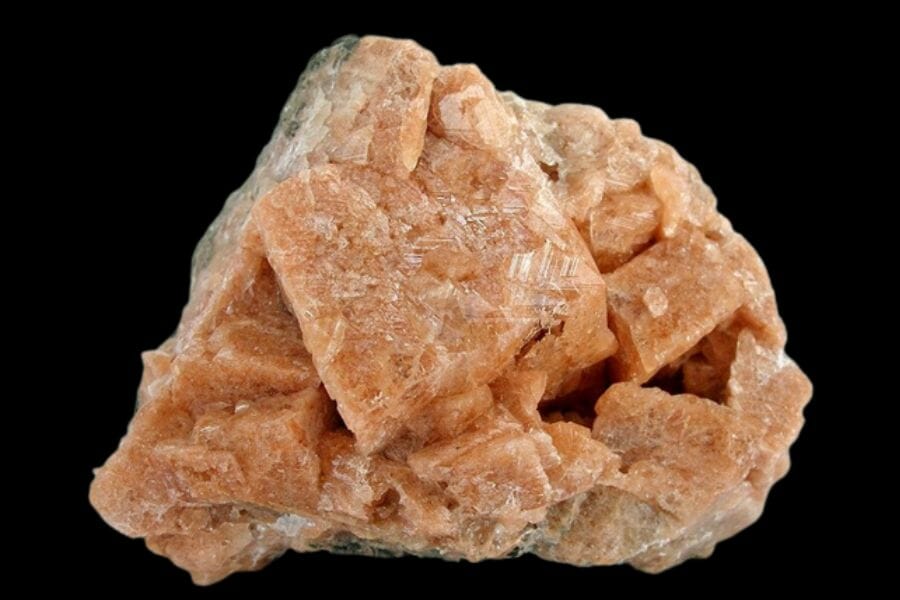
Gmelinite is a rare mineral that’s found in volcanic rocks. It’s named after the German mineralogist, Georg Gmelin, who first discovered it in 1778.
It’s prized for its unique crystal structures and vibrant colors. In fact, its structure is of great interest to geologists, as it provides insight into the conditions that existed when the mineral formed.
Throughout history, Gmelinite has been used for various purposes. In the 19th century, it was popular as a decorative stone for jewelry and other ornamental objects. More recently, it’s been used for scientific research, as its crystal structure makes it an ideal subject for studying the properties of zeolites, where it belongs.
Fun Fact: Gmelinite forms a unique crystal structure that shows striking, shallow, six-sided double pyramids. Can't imagine it? Just think of an angular flying saucer— Gmelinite is often said to look like it!
Where Gmelinite is found
Gmelinite is found in various but limited locations around the world, including Canada, France, Germany, and Russia. The minerals typically formed in cavities within volcanic rocks. It’s often found in basaltic and andesitic rocks, as well as in hydrothermal veins. Gmelinite is also found in geodes and in some alkali-rich volcanic deposits. However, it’s relatively rare and not commonly found in large amounts or deposits.
How you can identify a Gmelinite
- Color: Gmelinite’s color is usually a translucent white with an orange, yellow, or pink tint. It can vary based on the presence of impurities or mineral inclusions.
- Hardness: Gmelinite’s hardness is approximately 2.5 to 3 on Mohs scale. It’s a soft mineral that can be scratched easily by a fingernail and has low durability. It’s important to handle it carefully to prevent damage to its surface.
- Clarity: Gmelinite is generally cloudy or translucent. It can contain inclusions of other minerals, which affect its overall clarity. Its texture and luster are also significant factors that determine its clarity.
- Refractive index: Gmelinite’s refractive index is typically in the range of 1.42 to 1.44, which is moderate to low level for a mineral.
- Specific gravity: Gmelinite’s specific gravity is around 2.2 – 2.3. Since it’s porous, it’s relatively light compared to other minerals. This makes it easier to handle and process for industrial purposes.
Heulandite – (Ca,Na)2-3Al3(Al,Si)2Si13O36
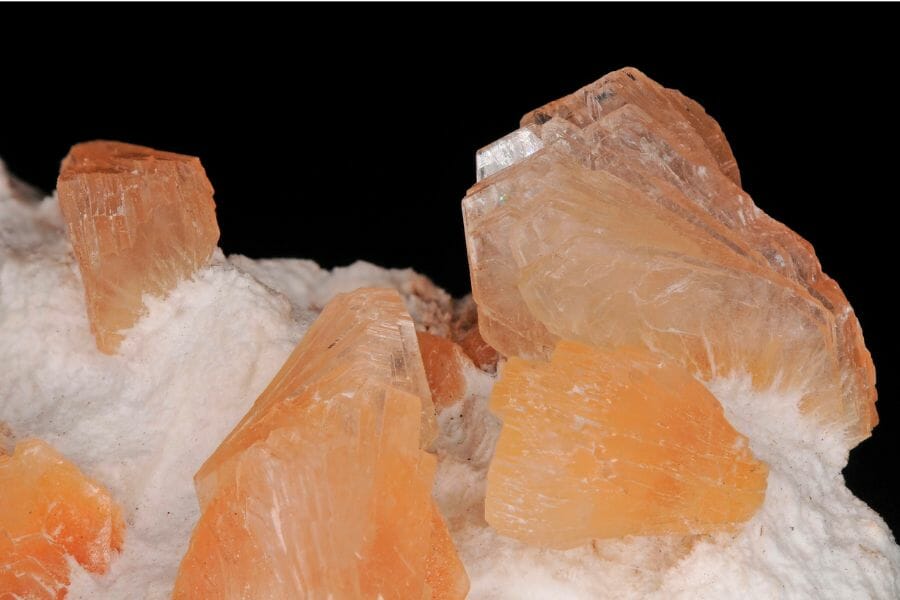
Heulandite was discovered in 1794 by a French geologist. It has a tectosilicate crystal structure and is composed of silica, aluminum, calcium, and sodium. It’s is commonly found with other zeolite minerals such as stilbite, natrolite, and phillipsite.
Throughout history, Heulandite has been used for various purposes, including as a decorative stone for jewelry and for ornamental purposes. It’s also been used for industrial applications, such as for water filtration and as a natural sorbent for toxic pollutants, since it has the ability to absorb and remove impurities from liquids and air.
Overall, Heulandite is a fascinating mineral with a long history of use and no doubt an eye-catching appearance, too!
Fun Fact: As a member of zeolite group of minerals, Heulandite is also among what's called, "boiling stones". When intensely heated, this mineral froths and bubbles— just like boiling liquid!
Where Heulandite is found
Heulandite is found in several countries across the world, including India, the US, Iceland, Germany, and the UK. The exact location depends on the type of Heulandite and the mineral deposit. In India, for example, it can be found in the state of Maharashtra, while in the US, it’s often found in California and New Jersey. In Iceland, Heulandite is found in volcanic areas, while in Germany and the UK, it’s typically found in cavities in volcanic rocks. Overall, the exact location of Heulandite can vary, but it’s usually found in volcanic regions.
How you can identify a Heulandite
- Color: Heulandite’s color varies from white to gray, yellow, pink, brown, orange, or red. It’s a popular collector’s mineral because of its unique crystal formations, that can grow to several centimeters in length.
- Hardness: The hardness of Heulandite varies, but it’s generally a soft mineral with a Mohs hardness of 4 to 5. It’s not known for its durability, but it’s prized for its beauty and delicate crystal formations.
- Clarity: Heulandite’s usually translucent to transparent. Its crystal structure has internal cavities and channels, which can cause light to scatter or refract as it passes through the stone, leading to a hazy appearance.
- Refractive index: The refractive index of Heulandite falls within a range of 1.485 to 1.490, which is considered medium. It means that light travels through it at a slower speed than it does through a vacuum, but faster than it does through glass.
- Specific gravity: Heulandite’s specific gravity is 2.2-2.5, which means that it’s relatively light for a mineral and floats in water.
Orpiment – As2S3
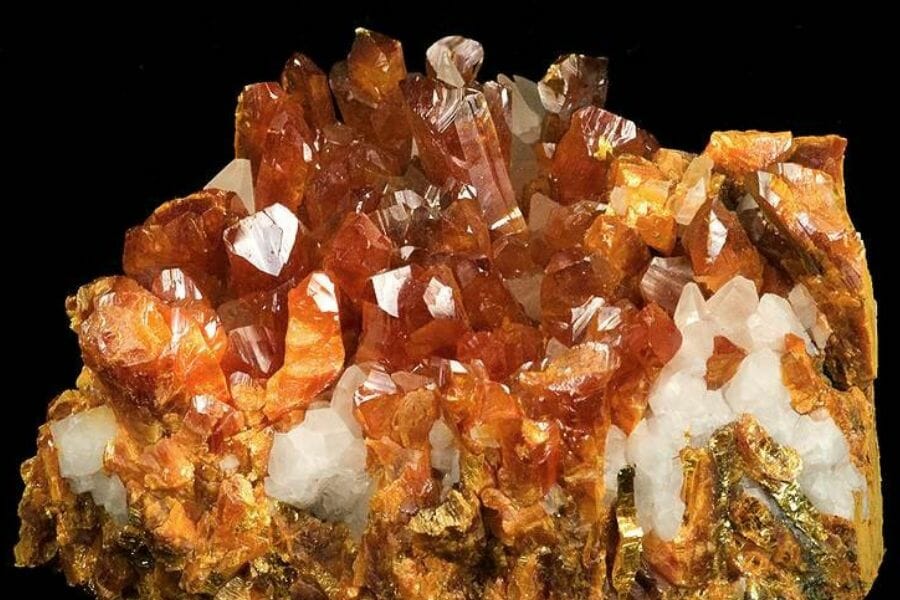
Orpiment has been used for centuries mostly for its bright pigmentation, which made it a popular pigment for painting and dyeing textiles. It was once used as a medicine to treat a variety of ailments, and was also believed to have magical powers.
In ancient China, Orpiment was used to make orange and yellow pigments for illuminated manuscripts and wallpaper. During the Middle Ages, it was used as a pigment in the production of stained glass windows. In the 19th century, orpiment was an important source of arsenic, which was used in the production of pesticides, herbicides, and other chemicals.
Today, it remains a popular mineral for collectors who love eye-catching pieces!
Orpiment is highly toxic and its use as a pigment or in medicine is highly discouraged. It is also important to handle orpiment with care as its toxic properties can be harmful to humans and the environment.)
Fun Fact: Orpiment is highly toxic! While useful in so many ways, its arsenic content is dangerous and can cause severe health problems if ingested or inhaled. So, if you'll ever get your hands on an Orpiment, be sure to take proper precaution.
Where Orpiment is found
Orpiment is found in various locations across the world, most commonly in Argentina, China, Russia, and Peru. It can also be found in smaller deposits in Kazakhstan, Tibet, and Turkmenistan. This mineral is often found near hot springs, volcanic vents, and sulfur deposits) It’s also sometimes found in association with realgar, which is another arsenic sulfide mineral. Copper, gold, and silver mines are other potential sources of Orpiment, as it can sometimes be found in veins and disseminated deposits in these types of mines.
How you can identify an Orpiment
- Color: Orpiment color is a bright yellow to yellow-orange hue. Its color is due to the presence of arsenic sulfur in its chemical composition.
- Hardness: Orpiment’s hardness is 2-2.5 on the Mohs scale. It’s relatively soft and it can be easily scratched with a fingernail. It has a brittle texture and is prone to cleavage along certain planes.
- Clarity: Orpiment is translucent, but not transparent, so it’s clarity isn’t very high. In some cases, it can even appear opaque.
- Refractive index: Orpiment’s refractive index ranges between 1.900-2.000. This means it has high dispersion of light, giving it a sparkling appearance when viewed under light.
- Specific gravity: Orpiment has a specific gravity of 3.5-3.8, which is considered heavy for a mineral. This is due to its dense, compact crystal structure.
Greenockite – CdS
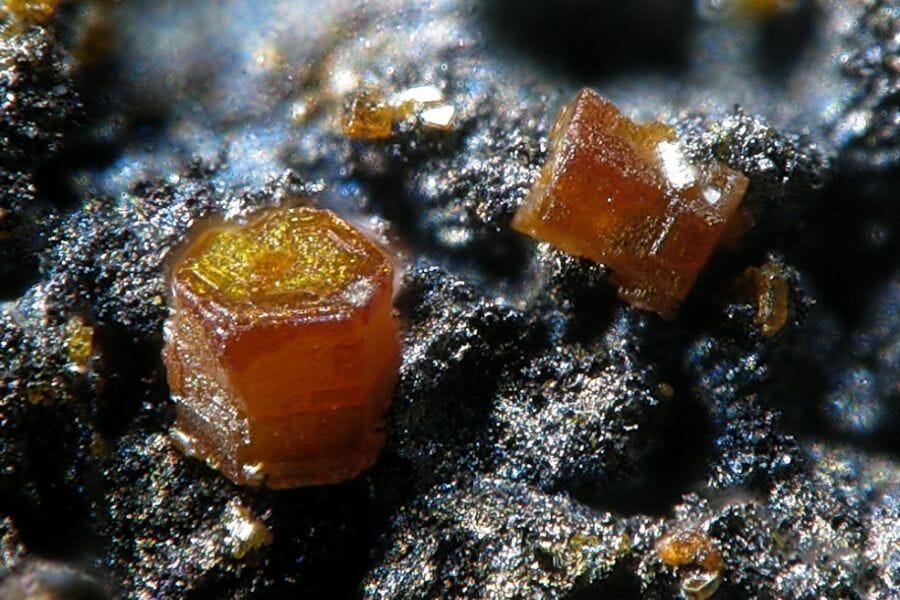
Greenockite was discovered in the Greenock mine in Scotland in 1832. It’s a great source of cadmium, a chemical element used in batteries, pigments, and coatings.
Throughout history, Greenockite was primarily mined for Cadmium, which was used in electroplating and pigments during the 1800s and early 1900s. Its usage has since expanded to the production of nickel-cadmium batteries, photovoltaic cells, and other electronic devices.
Greenockite is also of interest to collectors of mineral specimens because of its unique crystal formations. Today, it remains a crucial material in modern industry and a fascinating natural resource.
Fun Fact:
Greenockite is highly toxic, especially when inhaled in its powdered form. That's why the extraction and processing of cadmium from Greenockite requires proper safety measures. Despite this, it has played an important role in the development of modern technology and continues to be an important mineral resource.
Where Greenockite is found
Greenockite is found in a few places around the world, including deposits in Germany, Poland, Sweden, and the UK. It’s also been found in lead and zinc mines in the US. Despite this, Greenockite is a rare mineral, so it’s not easy to find.
How you can identify a Greenockite
- Color: Greenockite has a yellowish to orange-yellow color.
- Hardness: Greenockite’s hardness is rated around 2.5-3 on the Mohs scale. It’s relatively soft, and can easily be scratched by a fingernail. Aside from handling it with precaution from toxicity, it should be handled with care, too.
- Clarity: Greenockite’s clarity is typically opaque, which means it doesn’t allow light to pass through it. Although some specimens might have some translucency, it’s still rare.
- Refractive index: Greenockite’s refractive index is around 2.2-2.3, which is considered low, but it’s varies with impurities and crystal habit.
- Specific gravity: Greenockite’s specific gravity is around 6.5-6.7. It’s denser or heavier than most minerals due to its high levels of cadmium content.
Inesite – Ca2Mn7Si10O28(OH)2•5(H2O)
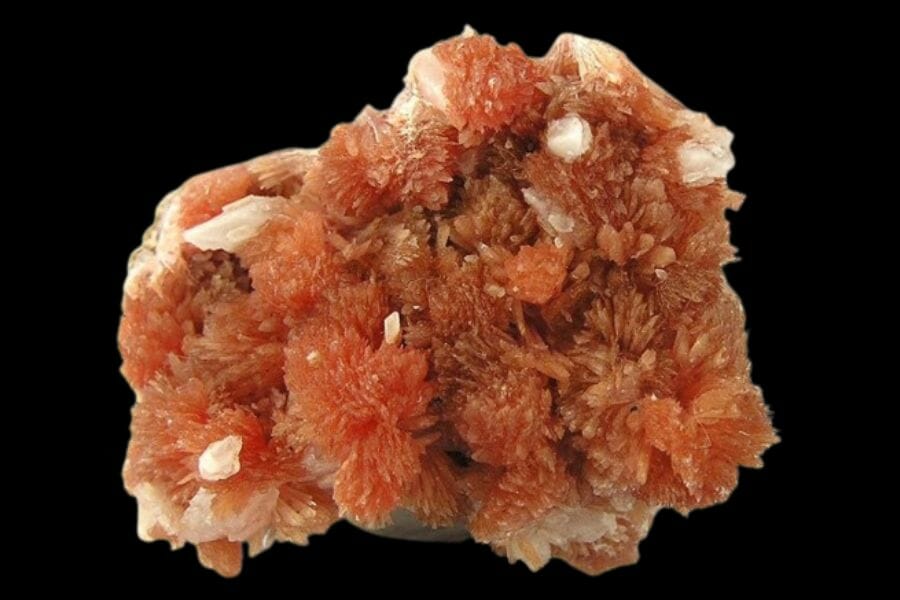
Inesite was discovered in 1967 and named after its place of origin in the Inez mine in California, USA. It’s valued by collectors for its unique crystal formations and interesting color combinations.
Inesite is not widely used in commercial applications and its occurrence is rare in nature, which contributes to its scarcity and, hence, higher value among collectors. It’s also interesting to scientists and geologists as it provides important information about the geological processes that formed the area where it is found.
Overall, Inesite is a fascinating mineral worth appreciating for its beauty, rarity, and historical significance.
Fun Fact
The name Inesite came from the Greek word, "ines" which means "fibers", owing to the common habit of this mineral t form unique and interesting crystal formations. Just look its photo!
Where Inesite is found
Inesite is found in several countries, including Australia, USA (California), Mexico, Germany and Italy. But most notably, it’s found in the famous Iyo-Yamaguchi Prefecture, Japan. It’s a rare mineral, commonly found in skarn deposits along with other minerals like epidote, vesuvianite, and axinite.
How you can identify an Inesite
- Color: Inesite is typically found in shades of orange, pink, red or brown. Its color is known to be due to the presence of iron and manganese in its chemical composition. Its exact hue also varies due to the presence of different impurities.
- Hardness: Inesite has a hardness of 4-4.5 on the Mohs scale, which is considered soft. It’s easily scratched by a fingernail and is not typically used in jewelry or other applications where durability is important.
- Clarity: Inesite’s clarity can range from transparent to translucent, but it’s typically not considered to be a highly clear mineral. Its clarity can be impacted by inclusions, cracks or other internal features that can affect its overall appearance.
- Specific gravity: Inesite’s specific gravity is around 3.5-3.6, meaning it’s denser than average minerals.
Norbergite – Mg3(SiO4)(F,OH)2
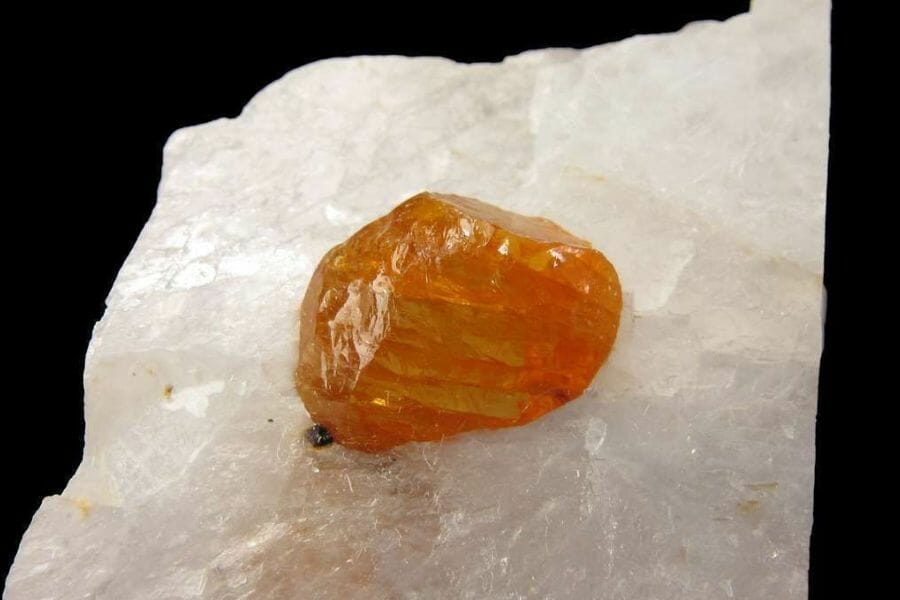
Norbergite was first discovered in Norberg, Sweden in the late 1800s, which is how it got its name. It’s not well known or widely used, but it’s valued by mineral collectors for its rarity and its distinctive crystal structure.
Norbergite is a hydrated sodium aluminum silicate, and it’s often associated with other zeolites such as heulandite, stilbite, and phillipsite.
This mineral has been used for industrial purposes, as it has a high cation exchange capacity, making it useful for removing heavy metal ions from water. However, this usage is relatively rare, and it’s mainly of interest to collectors and mineral enthusiasts.
Fun Fact Norbergite is known to have unique properties, such as its ability to fluoresce under ultraviolet light and its unusual crystal habit.
Where Norbergite is found
Norbergite is found in a few places around the world, including Sweden, Italy, and the US. In Sweden, it’s found in the Norberg mining area (hence its name), and in the US, it’s found in California and Montana. In Italy, it’s found in a few locations, including the Val D’Intelvi.
How you can identify a Norbergite
- Color: Norbergite is often described as having a white or colorless color, but some specimens can have bright orange hues.
- Hardness: Norbergite’s hardness on Mohs scale is 5.5. It’s a little harder than window glass but softer than a steel file.
- Specific gravity: Norbergite’s specific gravity is 3.16-3.18, which is slightly heavier than average. It falls in medium range of specific gravity for minerals.

